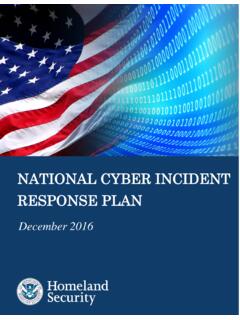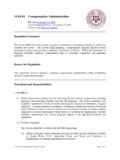Transcription of Hurricane Katrina: DOD Disaster Response
1 Order Code RL33095. CRS Report for Congress Received through the CRS Web Hurricane katrina : DOD Disaster Response September 19, 2005. Steve Bowman Specialist in National Defense Foreign Affairs, Defense, and Trade Division Lawrence Kapp Specialist in National Defense Foreign Affairs, Defense, and Trade Division Amy Belasco Specialist in National Defense Foreign Affairs, Defense, and Trade Division Congressional Research Service The Library of Congress Hurricane katrina : DOD Disaster Response Summary The issue that has received the most attention in post- katrina discussions is the speed of rescue and relief operations. The Department of Defense's (DOD's). Northern Command began its alert and coordination procedures before katrina 's landfall; however, many deployments did not reach the affected area until days later.
2 An examination of the timeline of DOD's Response and the decision points along that timeline could provide insight into whether the Response could have been accelerated given the intensity of the storm and the extent of the destruction. Both the National Response Plan and DOD's own Homeland Security Doctrine lay out extensive procedures and specific decision points in an attempt to ensure an organized Response to catastrophic incidents. It may now be necessary to examine those procedures and the actions of responsible authorities to determine whether procedural obstacles, administrative failures, or both delayed the arrival of needed resources in the affected area. The traditional assumption that the Department of Defense is the resource of last resort may also require re-examination.
3 As with most natural disasters, the role of the National Guard is critical in the maintenance of civil order, the provision of logistical support, and the coordination of rescue and relief effort. The National Guard's ability to respond through the Emergency Management Assistance Compact may be proven to have been exemplary, given the extent of regional destruction. Nevertheless, a number of issues may attract attention. The fact that the National Guard may act under state control or may be federalized and brought under command of active duty forces at the President's discretion creates a decision-point with political, cost, and coordination/command implications. It is not yet clear the extent to which, if any, these issues may have affected the speed and quality of Response to katrina .
4 They do, however, present a core concern in the balance of state and federal control in Disaster situations. Another issue that has attracted significant attention is the question of whether the demands of overseas operations in Iraq and Afghanistan in any way affected the quality of Response of both active duty and National Guard forces. Both DOD and the National Guard have denied any deleterious effect; however, there is some anecdotal evidence that equipment shortages among National Guard units and the non-availability of some active duty units could be attributed to overseas deployment activities. The National Guard's equipment levels and deployment policies may be of particular interest, given its dual responsibilities both domestically and overseas.
5 The Department Defense is currently preparing its Quadrennial Defense review (QDR) for submission to Congress in early 2006. In examining its roles, missions, and capabilities, it is likely that the controversies surrounding the federal Response to katrina will affect DOD's consideration of its responsibilities and its ability to execute them. Though katrina was a natural Disaster , many of its effects could be encountered in an intentional attack. Consequently, lessons learned from the katrina experience may carry long-term relevance for DOD's civil support planning. This report will be updated as events warrant. Contents Introduction .. 1. Organization of DOD Civil Support .. 1. Procedures for Obtaining DOD Civil Support.
6 3. Role of the National Guard .. 6. State Active Duty .. 7. Title 32 Status .. 8. Federal Status .. 9. Activation Statuses: Advantages and Disadvantages .. 10. DOD katrina -Related Appropriations .. 12. Issues for Congress .. 13. Timeline of Response .. 13. Structural or Administrative Failures? .. 13. Federalization of the Evacuation/Command of the National Guard .. 14. Impact of Overseas Deployments on DOD's Response .. 14. Impact of katrina on the Quadrennial Defense Review .. 15. List of Figures Figure 1. Assistance Request Procedures .. 4. List of Tables Table 1: Activated National Guard Personnel Serving in Louisiana and Mississippi .. 11. Hurricane katrina : DOD Disaster Response Introduction The issue that has received the most attention in post- katrina discussions is the speed of rescue and relief operations.
7 The Department of Defense's Northern Command began its alert and coordination procedures before katrina 's landfall, however many deployments did not reach the affected area until days after. An examination of the timeline of DOD's Response and the decision points along that timeline could provide insight into whether the Response could have been accelerated given the intensity of the storm and the extent of the destruction. Both the National Response Plan and DOD's own Homeland Security Doctrine lay out extensive procedures and specific decision points in an attempt to ensure an organized Response to catastrophic incidents. It may now be necessary to examine those procedures and the actions of responsible authorities to determine whether procedural obstacles, administrative failures, or both delayed the arrival of needed resources in the affected area.
8 The traditional assumption that the Department of Defense is the resource of last resort may also require re-examination. This report examines the existing Disaster Response procedures for the Department of Defense and how they were implemented, the use of the National Guard and its relationship to active duty forces, funds appropriated to date, and then discusses issues that may receive congressional consideration Organization of DOD Civil Support1. Reinforcing a long-standing tradition, Homeland Security Presidential Directive-5 states: The Secretary of Defense shall provide military support to civil authorities for domestic incidents as directed by the President or when consistent with military readiness and appropriate under the circumstances and the law.
9 The Secretary of Defense shall retain command of military forces providing civil support. The Secretary of Defense and the Secretary [of Homeland Security] shall establish appropriate relationships and mechanisms for cooperation and coordination between their two departments. In keeping with the National Response Plan (NRP) and the DOD Joint Doctrine on Homeland Security, DOD civil support is normally provided only when local, state, and other federal resources are overwhelmed ; and it is requested by the Lead 1. Prepared by Steve Bowman, Specialist in National Defense; Foreign Affairs, Defense, and Trade Division CRS-2. Federal Agency responding to an incident or natural This is a fundamental principle of DOD's approach to civil support: it is generally a resource of last resort.
10 The Secretary of Defense has the principal authority for DOD's provision of civil support. His office retains approval authority for all requests for assistance from civilian agencies and retains control of all DOD assets provided. In practice, the Office of the Assistant Secretary of Defense, Homeland Defense (ASD/HD) is delegated supervisory responsibility of the civil support mission area and coordination with the Department of Homeland Within the DOD Joint Staff, civil support responsibilities reside with the Joint Director of Military Support. Northern Command (NORTHCOM) has the operational responsibility for civil support for most of the United States. It carries out civil support missions with forces assigned as required from all the armed services, typically through the creation of a joint task NORTHCOM has a permanently assigned Joint Interagency Coordination Group comprising liaison officers from other DOD components and other federal agencies, including the Department of Homeland Security (DHS).















